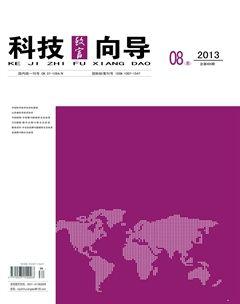FDI in the Extractive Sector: The Case of Colombia
Margarita Rodriguez O
【Abstract】The article present empirical evidence about the negative effects of FDI inflows over economic growth in the primary sector, in which developing countries, like most of Latin American countries, are the main exporters. One of the most important reasons for this negative relation between these two variables is the absence of spillovers in technology, knowledge, skills, etc.As probe of this negative effects, I analyze Colombia′s strategy “Mining Engine of growth”, which fits perfectly with the purpose of this study, as this Andean country is showing some symptoms of what is known as Dutch Disease and a lot of social and environmental problems related with the mining activities, especially in indigenous and natural reserves.
【Key words】FDI;Primary sector;Mining;Dutch Disease;Colombia
0.Introduction
In general,trade liberalization is a wide concept, which includes trade in goods,trade in services and financial resources.The latter is closely related to the other two, because it is the main source of Capital. The free movement of financial resources can be divided in two types, financial resources or non-financial resources.Non-financial resources are defined as long term investments,like joint ventures,establishment of companies or subsidiaries in foreign countries,etc.,also known as Foreign Direct Investment ( FDI).
As one of the main aspects of globalization and liberalization,FDI has become a fundamental part of countries′ development strategy, especially developing countries.Those strategies differ from each other according to the country′s development level,its endowments,its comparative advantage, etc.,but in general all strategies are based on two fundamental principles:attract foreign investment and benefit from it.
But does all FDI benefit the host country?Although,there is a general consensus about the importance of FDI as source of capital, technology, knowledge,good practices,productivity,etc.,nowadays,there have been some concerns about its marginal contribution to the development of the host country and its negative environmental and social effects.
1.Impacts of FDI over economic growth in the extractive sector
In relation with this subject, there is a growing number of studies which suggest that the benefits from FDI depend on the type of investment(M&As; or Greenfield),sector of investment(primary,manufacture,services),purpose of investment(efficient-seeking,market-seeking or resource-seeking) and characteristics of the host country, particularly, its institutions and human capital.But for the purpose of this study we will just focus in the relation between FDI and economic growth in the primary sector, which includes extractive activities.
The first economist that studied this specific subject was Albert Hirschman (1958),who emphasizes that not all sectors have the same potential to absorb spillovers and create linkages with the rest of the economy;he also suggest that “linkages are weak in agriculture and mining”.In a more recent publication made by the United Nation Conference of Trade and Development (UNCTAD) it is suggest that “in the primary sector,the scope for linkages between foreign affiliates and local suppliers is often limited”.Continuing with this analysis,Alfaro (2003) found econometrical evidence about the negative relation between FDI and economic growth in the primary sector.Finally in terms of spillovers,which are consider as the prize of FDI,Koko (1994) suggest that when companies operate in “enclaves”,like the mining and oil industries, the potential of spillover in host economy are limited.
2.“Mining Engine of Growth”
In recent years,the commodity and capital markets offer an exceptional opportunity for Colombia to attract FDI to its extractive sector,therefore the current president,Juan Manuel Santos,have design a new policy,known as “Mining Engine of Growth”,in which the mining and oil sector are the main actors of Colombia′s development.
As the extractive sector(mining and oil) is intensive in capital,a factor than most of developing countries lack,including Colombia, President Santo′s strategy offer tax incentives,reduction of royalties and stability contracts in order to promote investment in this sector.So far, the strategy has been successful in terms of FDI inflows in both activities; Figure 1 shows that in 2011,petroleum and mining sectors were the main receptors of FDI,reaching a value of 5.083 millions of dollars and 2.546 million, respectively;both representing 56% of the total inward FDI in the country.
Figure 1. Colombia′s Inward FDI by Sectors (2011)
Although,Colombia′s inward FDI have been always targeting the primary sector,since the possession of President Santos and the beginning of the strategy “Mining Engine of Growth”, FDI inflows has growth 101% during 2011.The massive entrance of capital flows has generated the revaluation of the Colombian peso in 10.9%,during the first trimester of 2012,becoming World′s more revaluating currency.This aspect has negative effects over Colombia′s exports and the productivity of non-extractive sectors.Besides,Colombia′s strategy does not diversify its industry and doesn′t generated considerable levels of employment for skill or unskilled population;instead the Andean country is increasingly dependent on the primary sector and international commodities prices. Moreover,as Colombia′s government offer enormous fiscal advantages,low royalties,subsidies and all short of guaranties to FDI in the extractive sector, its revenue does not satisfies the country necessities to improve its conditions for a sustainable development.
These factors are known in economics as the symptoms of Dutch Disease,which many analysts believe Colombia′s economy may be suffering and whose long-term effects can be fatal for the country's development.
3.Conclusion
Although,FDI has positives effects over economic growth,these effects vary across sectors.There is empirical evidence about the positive relation of FDI over growth in manufacturing and service sectors,but in the case of primary sector the relation is negative.This difference can be explained by the potential of these sectors to generate spillovers in technology,know how,productivity,skills,institutions,etcThe services sectors offer the highest potential and the primary sector the lowest.
Besides the empirical evidence,there are other factors that can explain the negative relation between inward FDI and economic growth in the primary sector.First,the extractive nature of FDI in this sector might generate benefits in the short run, but without a correct policy to transform resource returns into productivity assets,FDI in these activities will not generate sustainable development.Therefore,the challenge for Colombia′s government is to focus more in the long term benefits rather than economic trends and promote inward FDI in sectors with more potential spillovers and linkage with the rest of the economy.

